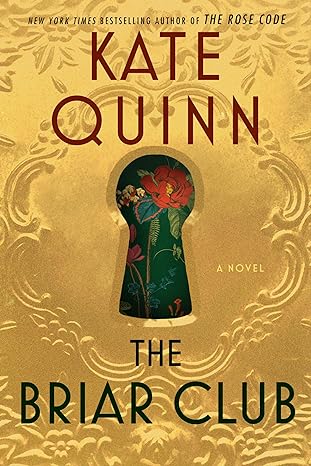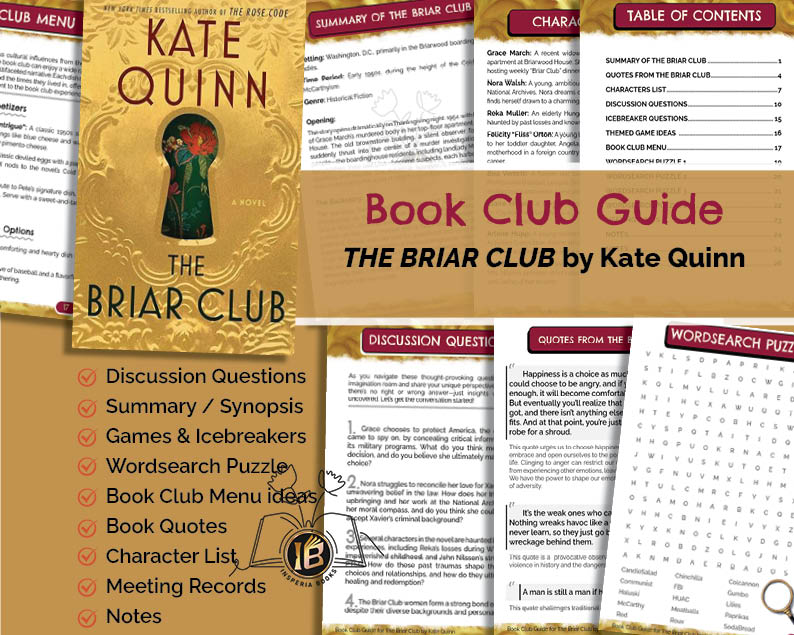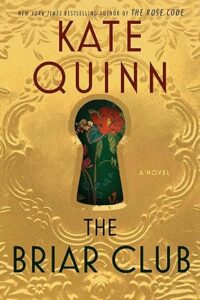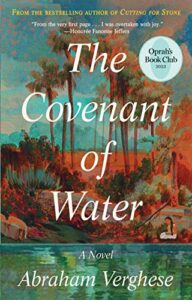
First Published: July 2024
Genre: Historical Fiction, Mystery
Time Period: 1950–1956
Setting: Washington, D.C.
Pages: 398
Chapters: 9
Table of Contents
Summary of The Briar Club by Kate Quinn
The whole thing kicks off on Thanksgiving, 1954, inside a Washington, D.C. boardinghouse that’s seen better days. A corpse lies in a pool of blood. Through the keyhole of an attic apartment, we see a world of trouble, and Briarwood House itself, the narrator in these moments, is both shocked and a little thrilled by the excitement. A detective is on the scene, but the house knows something he doesn’t: the killer is still in the building, one of the seventeen people milling about in the kitchen downstairs. The victim is unidentified, but the apartment belongs to a Mrs. Grace March. From this bloody, immediate present, the story throws itself back four and a half years to ask, how on earth did we get here?
It’s June 1950. The story picks up through the eyes of Pete Nilsson, the teenage son of the boardinghouse’s prickly landlady. Pete is a boy lost in the pages of Mickey Spillane novels, dreaming of being a private eye. His world, and the quiet, disconnected world of Briarwood House, is turned on its head by the arrival of Grace March. She’s a charming, mysterious woman from Iowa who takes the tiny, undesirable attic room (the future crime scene) and sees not a dump, but a place with “potential.” And almost immediately, she begins to change things. My first impression of Grace was that she’s a classic catalyst character, but her methods are so subtle. She brings the disparate women of the house together not through grand gestures, but with small acts of community: a jar of sun tea, a plate of sandwiches, an impromptu gathering to listen to President Truman announce the “police action” in Korea. She nurtures the women, and Pete, seeing the potential in all of them. This is the birth of the “Briar Club,” an informal sisterhood that forms around Grace’s kitchen table.
Each chapter then shifts focus to one of the women, gradually revealing the secrets they all carry. There is Nora Walsh, a sharp secretary at the National Archives from a family of corrupt Irish cops. She finds herself in a complicated romance with Xavier Byrne, the owner of a local bottle club who is revealed to be a high-ranking member of the Warring crime family. When Nora witnesses him commit a brutal act of violence, she is pulled into a world she was desperately trying to escape. Then you have Reka Muller, an elderly Hungarian artist and refugee, bitter and closed-off, who fled the Nazis only to have her family’s priceless Klimt sketches stolen by her American sponsor. Her story is one of deep loss and simmering rage.
Fliss Orton is the bubbly English war bride, outwardly perfect but internally crumbling under the weight of motherhood and postpartum depression while her doctor husband serves in Tokyo. Bea Verretti is a former star of the All-American Girls Professional Baseball League, her career cut short by a knee injury, now adrift and teaching PE to uninterested teenagers. And there is Claire Hallett, a cynical, tough-as-nails secretary for Senator Margaret Chase Smith who is hiding a traumatic past from the Great Depression and a secret, dangerous love affair. Circling them all is Arlene Hupp, a petty and ambitious Texan working for the House Un-American Activities Committee, who embodies the paranoia of the McCarthy era and serves as the group’s initial antagonist.
The story moves forward through the years, marked by suppers, secrets shared, and small kindnesses. The women, initially just ships passing in the night, become a found family. They help Lina, Pete’s sister, get new glasses. They support Bea in her quest to become a baseball scout. They tolerate Arlene. Through all this, Grace remains the calm center, the listener who never shares her own past. The interstitial sections, narrated by the personified Briarwood House, provide a unique perspective. The house awakens from a long slumber, growing fond of its ladies, watching their lives intersect, and dropping hints about the tragedy to come.
What was Grace’s secret? We learn she is Galina Stepanova, a defected Soviet spy. Trained in a mock American town and paired with a ruthless partner, Kirill, she was inserted into the U.S. during the Cold War. But the abundance and freedom of America, contrasted with her own past surviving the Leningrad siege where her family starved, caused her to break. She disappeared from her mission, taking with her a file of top-secret aviation plans from Lockheed Martin’s Skunk Works, and created a new identity as Grace March.
The story comes full circle on that fateful Thanksgiving in 1954. All the women of the Briar Club, along with their various lovers and friends, are gathered for a true feast. The first murder victim is Kirill, Grace’s former partner. He tracked her down after seeing a newspaper photo of her at Lina’s Pillsbury Bake-Off competition. He arrives intending to kill her for her treason. In a frantic chase through the house, he attacks Fliss before Grace confronts him in her attic room. Her pistol misfires, but Bea, the ex-ballplayer, arrives just in time and cracks Kirill with her baseball bat. Grace grabs Kirill’s own weapon—a garden sickle—and finishes the job.
As the house reels from this, a second man arrives: Barrett Sutherland, the abusive husband of Claire’s lover, Sydney. Drunk and enraged, he followed Sydney to Briarwood House. In the chaos that follows, he attacks Harland (Bea’s FBI boyfriend) and threatens the women. Arlene, fueled by years of resentment and the patriotic fervor of the Red Scare, mistakes him for another Communist spy and kills him with Bea’s bat.
This is the ending. Two bodies. One a Soviet agent, the other a senator’s son. The police are on their way. Now the Briar Club faces its greatest test. They must decide whether to turn Grace in or protect her. In a tense, emotional debate, they choose loyalty. Led by Harland, they fabricate a story for the police: Kirill was a lone, crazed intruder who killed Sutherland before being killed himself in a struggle. They all cry, play their parts as hysterical women, and the police buy it.
In the aftermath, Grace knows she cannot stay and put her friends at further risk. She packs her bags, but she doesn’t leave alone. She takes the fragile, now-broken Arlene with her, intending to care for her. The final pages jump forward to May 1956. Briarwood House is thriving under the care of Pete and his father, who has returned. Pete, now a young man, receives an unsigned postcard from New York showing the Brooklyn Bridge. It’s from Grace, writing about helping with Arlene’s wedding plans and sending her love to the Briar Club.
List of Characters in The Briar Club
This list below contains all the characters in The Briar Club including the residents of Briarwood House & Family, the men in their lives, other key figures and minor characters.
Residents of Briarwood House & Family
- Grace March: A charming and enigmatic woman from Iowa who moves into the attic apartment and becomes the heart of the boardinghouse.
- Pete Nilsson: The landlady’s teenage son, an avid reader of detective novels who is observant and kind.
- Mrs. Nilsson: The stern, frugal, and often-disapproving landlady of Briarwood House.
- Lina Nilsson: Pete’s younger sister, a shy girl who loves to bake.
- Nora Walsh: A smart, principled secretary at the National Archives from a family of policemen.
- Reka Muller: An elderly, gruff Hungarian artist and refugee who works at the local library.
- Fliss Orton: A perky and seemingly perfect English war bride and mother.
- Bea Verretti: A former star shortstop for the All-American Girls Professional Baseball League, now a PE teacher.
- Claire Hallett: A sharp-tongued, cynical secretary working for a senator on Capitol Hill.
- Arlene Hupp: A socially ambitious Texan who works for the House Un-American Activities Committee (HUAC).
- John Nilsson: Pete and Lina’s estranged father who was a Marine in the war.
The Men in the Lives of the Briar Club Women:
- Xavier Byrne: The quiet, intense owner of the Amber Club, a local bottle club, who is connected to the Warring crime family.
Harland Adams: A straitlaced FBI agent from Virginia who is dating Arlene.
Dr. Dan Orton: Fliss’s husband, an army doctor serving his tour in Tokyo.
Joe Reiss: A jazz saxophonist who lives next door and becomes a regular at the Briar Club gatherings.
JD: An assistant pitching coach for the Washington Senators who briefly dates Grace.
Claude Cormier: A drummer in Joe Reiss’s jazz trio.
Kirill Lensky (Bob McDowell): A mysterious man from Grace’s past.
Other Key Figures:
Sydney Sutherland: The elegant and beautiful wife of a rising politician.
Barrett Sutherland: Sydney’s ambitious and powerful husband.
Timothy “Timmy” Walsh: Nora’s older brother, a police sergeant who frequently asks her for money.
George Harding: A small-time criminal with a violent history connected to Nora.
Briarwood House: The boardinghouse itself, which serves as an occasional narrator.
Minor Characters:
Angela Orton: Fliss’s spirited baby daughter.
Bear Sutherland: Sydney and Barrett’s young son.
Senator Margaret Chase Smith: Claire’s principled boss in the Senate.
Mr. Harris: Nora’s boss at the National Archives.
Mr. Royce: The lecherous principal at the school where Bea teaches.
Louise: Xavier Byrne’s housekeeper.
Dr. John Rock: A fertility specialist in Boston and Dan Orton’s uncle.
Mr. Huckstop: A local photographer with a side business.
Mr. Rosenberg: The Jewish owner of the deli next to Briarwood House.
Elizabeth Bandyk: Bea’s friend and fellow player from the AAGPBL.
Miss Wing & Miss Haskell: Claire’s senior colleagues in Senator Smith’s office.
Book Club Questions For The Briar Club
The questions have been curated to spark meaningful discussions in your book club meeting.
Grace March is the catalyst for everything that happens at Briarwood House. Do you see her as a benevolent force, a manipulator, or something in between? Did her methods for bringing the women together justify the deception of her hidden identity?
Each woman in the Briar Club is battling her own demons from the past. Whose personal history did you find the most compelling or surprising?
Let’s talk about Arlene Hupp. For much of the book, she’s the antagonist. By the end, did your opinion of her change? Did she deserve Grace’s final act of kindness ?
Compare the relationships of Nora and Xavier with Bea and Harland. Both men operate within systems of law and order (or crime). What do these two very different relationships reveal about love, loyalty, and what each woman was looking for in a partner?
Briarwood House itself acts as a narrator in the interstitial sections. What did you think of this choice? Did it add a unique layer to the story for you, or did you find it distracting?
Pete Nilsson undergoes a profound transformation throughout the book. What do you think was the single most important event or relationship that shaped his journey?
Near the end, Grace says, “I have always been a friend. To all of you.” Do you believe her? Was her friendship genuine from the start, or did it become real over time as she lived her new life?
Did you believe Harland Adams would have turned Grace in if the other women hadn’t argued so persuasively? What did his internal conflict say about the struggle between duty to country and duty to conscience during that era?
The inclusion of recipes at the end of each section is an unusual touch. Did this add to your enjoyment of the book? Did you see the food as just a cozy detail, or did it represent something more, like nourishment, community, or care?
Fliss Orton’s quiet battle with postpartum depression feels very contemporary. Why do you think the author chose to include this storyline, and what does it reveal about the hidden struggles of women, even in the supposedly idyllic 1950s?
If you loved these book club questions and want more like these from other historical fiction books, we have created Comprehensive Book Club Guide Kits for various must-read book club books. These guides provide everything you need to host a lively and engaging book club meeting, including:
- Thought-provoking discussion questions in printable PDF format that will help you explore the novel’s themes.
- Fun icebreaker questions to get your discussion started.
- Challenging word search puzzles based on the novel’s characters and events.
- Delicious food and drink ideas inspired by the novel.
- Insightful book quotes with explanations to help you understand the novel’s deeper meaning.
- Meeting record templates to take notes and keep track of your discussions, and so much more!
These guides are perfect for book clubs of all sizes and experience levels. They are also a great resource for individual readers who want to deepen their understanding of the novels.
The Briar Club Recipes
One of the special things about Kate Quinn’s The Briar Club is that it includes recipes that are important to the characters and the story.
At the end of each chapter or major section, you’ll find a recipe for a dish or drink that was featured in that part of the book, giving you a real taste of the 1950s setting and the community built around food.
The book offers a full menu of recipes connected to the women of Briarwood House. You’ll discover how to make:
Comforting Meals: Pete’s Swedish Meatballs, Nora’s Colcannon, Reka’s Haluski, Claire’s Potato Pancakes, and a rich pot of Bea’s Ragù.
Classic 1950s Dishes: Harland’s Fried Chicken and the truly unforgettable Arlene’s Candle Salad.
Soups & Stews: A savory Rassolnik from Grace’s past and Claude’s Gumbo from his Louisiana roots.
Desserts and Sweets: Fliss’s Strawberry Fool, Lina’s incredible Eight-Layer Honey Cloud Cake, and Sydney’s Fried Bananas with Bermuda Rum.
Drinks: You’ll even find recipes for simple pleasures like Grace’s Sun Tea and a signature cocktail named Briarwood House’s Good Night and Good Luck.
Frequently Asked Questions - The Briar Club
What is the Briar Club book about?
The Briar Club by Kate Quinn is a historical mystery about the women of a 1950s Washington, D.C. boardinghouse who form an unlikely sisterhood. Their lives, full of dangerous secrets, are upended by a mysterious newcomer and a shocking murder that threatens to expose them all.
Is the Briar Club based on a true story?
The Briar Club is historical fiction, not a direct true story, but it’s richly inspired by real history. Kate Quinn blends true events from the 1950s—like Cold War spies, the McCarthy era, and Washington D.C. crime families—into the lives of her fictional characters.
My Review of The Briar Club by Kate Quinn
I found myself completely captivated by The Briar Club. This book took me on a journey back to 1950s Washington D.C., a world both familiar and foreign, where the lives of several extraordinary women intertwine at the mysterious Briarwood House.
From the moment I cracked open this book, the murder at Briarwood House had me hooked. Who was dead? And who was the killer lurking among the seemingly ordinary residents? The attention to historical detail is chef’s kiss – Quinn’s research shines through, painting a vivid picture of an era grappling with the Red Scare and stifling expectations for women. As someone who loves learning about different time periods, this was a treat.
But what really got me were the characters. These women! Each one is so richly drawn, with their own struggles, secrets, and triumphs. They’re flawed, complex, and so incredibly real. The way their friendships developed, forming a chosen family in the face of adversity, hit me right in the feels.
Now, I have to admit, the pacing did test my patience at times. Some chapters felt a bit long-winded, and I found myself wishing things would move along a little quicker. But you know what? In the end, I appreciated the deep dive into each character’s backstory. It made their journey all the more meaningful.
The multiple perspectives, including the house itself (how cool is that?), added layers to the story that kept me engaged. And can we talk about those plot twists? Just when I thought I had it all figured out, Quinn threw me for a loop. I was guessing until the very end! Plus, there are even some fun recipes in the book, like Grace’s Sun Tea, which was a neat bonus!
While the mystery aspect wasn’t as gripping as I expected (honestly, I was more invested in the characters’ personal dramas), it didn’t detract from my overall enjoyment. If anything, it added a nice bit of intrigue to keep things spicy.
In the end, The Briar Club left me feeling warm, inspired, and a little nostalgic for a time I’ve never known. Just be prepared to settle in for the long haul – this isn’t a quick beach read, but trust me, it’s worth the time investment.
Kate Quinn Biography
Kate Quinn is a New York Times bestselling author celebrated for her immersive historical fiction that masterfully blends intrigue with rich character detail. Her recent string of blockbuster novels, including her breakout hit and Reese Witherspoon Book Club pick, The Alice Network, has cemented her as a giant in the genre. Her other acclaimed 20th-century standalone novels include The Huntress, The Rose Code, and The Diamond Eye.
For readers looking for Kate Quinn books in order, her career began with two captivating series set in earlier eras: the Empress of Rome Saga and The Borgias duology. With her latest bestseller, The Briar Club, Quinn once again delivers a riveting story of secrets and sisterhood, proving why she is a must-read for any fan of historical mysteries.
Was this post helpful?
We’d love to hear from you : )




